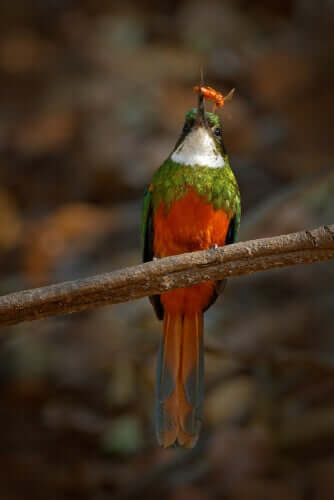Jacamar Bird - Characteristics of a Passerine

The jacamar bird is the best-distributed species of the Galbulidae family. Jacamars is a general term for a group of birds that belong to this family. They’re all throughout the American tropical zone and are their striking colors are characteristic of their suborder.
General characteristics
You can subdivide jacamar into five different genera:
- Galbacyrrhynchus
- Brachygalba
- Jacamaralcyon
- Galbula
- Jacamerops
In general, these birds have a slender body that varies in size. Small and medium specimens are common. Their wings are rounded and, in addition, their elongated beak allows them to catch insects on the fly.
The hue of the plumage varies according to the species and they can either have muted tones or go to the other side of the color spectrum and have iris-colored tones.
We could say that the most representative species of this family belong to the genus Galbula as a Galbula ruficauda. Additionally, this bird is commonly known as the Jacamar colirrufo, which means “Rufous-tailed jacamar.”
Characteristics of the Rufous-tailed jacamar bird
This is a bird of bright colors. Mainly green, with reddish tones. Their tail has a rather attractive tonality, which may be what gave rise to their denomination as “colirrufo.”
In this particular case, “rufa” refers to the blond or reddish tones (the word has other meanings). It may also mean “colorful.” The outer and central part of the tail is usually of the same color as their wings. These, in turn, have a beautiful metallic green color, while the inside of their tail ranges from reddish to orange in hue.
Galbula ruficauda
This jacamar bird measures between 6 1/2 and 11 inches. In contrast, it weighs between only 0.6 and 1 ounce. Their black beak is considerably long and reaches a length of between 1 37/64 and 2 3/4 inches.
This bird is slender and small in size, and the sexual dimorphism between females and males is quite evident. Males have a white throat, while the female’s is beige. Their song is a loud shriek that often amuses those who hear it.
You can also differentiate the adult specimens from the immature. Usually, immature specimens have a smaller tail and beak and are more opaque in hue.
Habitat and distribution
Jacamar colirrufo birds inhabit the wooded regions of the Neotropic, specifically in a new land or in old dry thickets. They live in different countries, from Mexico to Argentina, as well as Central America, Colombia, Ecuador, Venezuela, Brazil, Bolivia, and Paraguay, among others.
They’ve been spotted in Colombia about 2950 feet above sea level on the Pacific slope. However, you’d have to go as high as 4265 feet to find one in the Magdalena Valley.
Diet of a Jacamar colirrufo bird

The Galbula ruficauda is predominantly insect-eating. They munch on species of different orders, such as Lepidoptera, Odonata, Isoptera, Hemiptera, Hymenoptera, Orthoptera or Coleoptera, among others.
Depending on the region in which you spot them, these birds hunt depending on the number of specimens of a specific order they may find. For example, in Costa Rica they mainly eat butterflies.
One could say that Jacamar Colirrufo is specialized in hunting fast-flying prey, among them butterflies and dragonflies.
When they catch their prey, they shake it and hit it against their perch. The goal of hitting them is so they lose their wings and are, therefore, unable to escape.
State of conservation
Galbula ruficauda is on the list of the International Union for the Protection of Nature (IUCN) as a bird of low concern. This implies they’re not in immediate danger of extinction.
However, although populations are not severely fragmented, the number of specimens is definitely decreasing. These are some of the threats that may be influencing the decline of specimens of this species:
- Hunting pressure
- Human presence
- Loss of their habitat
Interesting facts about the Jacamar colirrufo bird
The jacamar bird belongs to the species of the family Galbulidae which is more widely extended. Its distribution begins in Central America and reaches South America.
There are a total of six subspecies of Galbula ruficauda.
Throughout their courtship, the male provides food for the female. The two members of the couple jointly dig a burrow, which has a nest in the center. Then, after laying the eggs, both the male and the female incubate the eggs. This is a great example of teamwork in nature.
Thanks for reading this article, you might also enjoy reading about the bird of paradise, another passerine.
All cited sources were thoroughly reviewed by our team to ensure their quality, reliability, currency, and validity. The bibliography of this article was considered reliable and of academic or scientific accuracy.
-
Jacamará colirrufo – eBird [Internet]. [citado 29 de junio de 2019]. Disponible en: https://ebird.org/species/rutjac1?siteLanguage=es_ES
-
Patrimonio emplumado de la Universidad del Norte. Guía de campo – Juanita Aldana Domíguez, Carrol Gómez de la Rosa , Rafael Borja Acuña – Google Libros [Internet]. [citado 29 de junio de 2019]. Disponible en: https://books.google.es/books?id=8Wo2CwAAQBAJ&pg=PA81&dq=Galbula+ruficauda+espa%C3%B1ol&hl=es&sa=X&ved=0ahUKEwimxZL82ozjAhVq8eAKHVbbAiIQ6AEIKDAA#v=onepage&q=Galbula%20ruficauda%20espa%C3%B1ol&f=false
-
Wiki Aves de Colombia – Universidad Icesi – Cali, Colombia | Jacamar Colirufo [Internet]. [citado 29 de junio de 2019]. Disponible en: http://www.icesi.edu.co/wiki_aves_colombia/tiki-index.php?page=Jacamar+Colirufo
- BirdLife International 2016. Galbula ruficauda. The IUCN Red List of Threatened Species 2016: e.T22682200A92934430. http://dx.doi.org/10.2305/IUCN.UK.2016-3.RLTS.T22682200A92934430.en. Downloaded on 28 June 2019.
This text is provided for informational purposes only and does not replace consultation with a professional. If in doubt, consult your specialist.